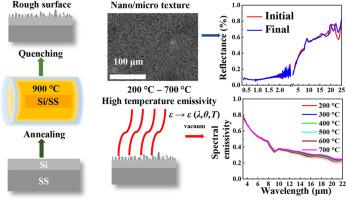In situ high-temperature emissivity measurements of heat-treated, silicon coated stainless steel for solar thermal applications
IF 6.3
2区 材料科学
Q2 ENERGY & FUELS
引用次数: 0
Abstract
Understanding thermal emissivity at high temperatures is crucial for developing efficient materials for solar thermal applications. We present a new approach for creating an efficient material for solar absorber by developing a nano structured surface on stainless steel substrate through Si deposition and annealing. We prepare five samples by annealing them at five temperatures between 700 °C and 1100 °C. Afterwards, we perform a systematic study of the spectral emissivity at elevated temperatures, focusing on different parameters: angle dependence, wavelength dependence, and temperature dependence. The spectral directional emissivity experiments performed in the mid-infrared range reveal a dielectric behavior of the samples in the short wavelength region (λ < 6 μm) and metallic behavior in the long wavelength region (λ > 12 μm). The results indicate an increase in hemispherical and total normal emissivity with measurement temperature (from 200 °C to 700 °C), influenced by oxide/silicide formation due to interdiffusion, and by surface roughness. Notably, samples annealed at 900 °C and 1000 °C demonstrate enhanced thermal stability at 700 °C, showcasing promising characteristics for high-temperature applications. Consequently, this study presents a viable method for developing cost-effective silicon-based solar absorber coatings on stainless steel with tailored properties for solar thermal applications along with its real time high temperature emissivity details.

热处理硅涂层不锈钢的原位高温发射率测量,用于太阳能热应用
了解高温下的热发射率对于开发高效的太阳能热应用材料至关重要。我们提出了一种新方法,通过硅沉积和退火在不锈钢基底上形成纳米结构表面,从而制造出高效的太阳能吸收器材料。我们通过在 700 °C 至 1100 °C 之间的五个温度下退火制备了五个样品。随后,我们对高温下的光谱发射率进行了系统研究,重点关注不同的参数:角度依赖性、波长依赖性和温度依赖性。在中红外范围内进行的光谱定向发射率实验显示,样品在短波长区域(λ < 6 μm)具有介电特性,而在长波长区域(λ > 12 μm)具有金属特性。结果表明,随着测量温度的升高(从 200 °C 到 700 °C),半球发射率和总法线发射率也随之升高,这是受相互扩散形成的氧化物/硅化物以及表面粗糙度的影响。值得注意的是,在 900 ℃ 和 1000 ℃ 下退火的样品在 700 ℃ 下的热稳定性得到了增强,为高温应用展示了良好的特性。因此,本研究提出了一种可行的方法,用于在不锈钢上开发具有太阳能热应用定制特性的经济高效的硅基太阳能吸收涂层,并提供了其实时高温发射率详情。
本文章由计算机程序翻译,如有差异,请以英文原文为准。
求助全文
约1分钟内获得全文
求助全文
来源期刊

Solar Energy Materials and Solar Cells
工程技术-材料科学:综合
CiteScore
12.60
自引率
11.60%
发文量
513
审稿时长
47 days
期刊介绍:
Solar Energy Materials & Solar Cells is intended as a vehicle for the dissemination of research results on materials science and technology related to photovoltaic, photothermal and photoelectrochemical solar energy conversion. Materials science is taken in the broadest possible sense and encompasses physics, chemistry, optics, materials fabrication and analysis for all types of materials.
 求助内容:
求助内容: 应助结果提醒方式:
应助结果提醒方式:


